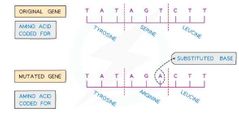![]()
![]()
![]()
Use LEFT and RIGHT arrow keys to navigate between flashcards;
Use UP and DOWN arrow keys to flip the card;
H to show hint;
A reads text to speech;
29 Cards in this Set
- Front
- Back
|
Gene Mutation |
A change in the sequence of base pairs in a DNA molecule that may result in an altered polypeptide. |
|
|
Main ways a Mutation can occur |
Insertion, Deletion and Subsitution |
|
|
Insertion (Mutation) |

A mutation that occurs when a nucleotide is randomly inserted into the DNA sequence. It changes the amino acid that would have been coded. |
|
|
Deletion (Mutation) |
A mutation that occurs when a nucleotide is randomly deleted from the DNA sequence, this changes the amino acid that would have been coded for. |
|
|
Silent Mutations (Subsitution) |
The mutation does not alter the amino acid in the polypeptide as certain codons code for the same amino acid. |
|
|
Subsitution (Mutation) |

A mutation that occurs when a base in the DNA sequence is randomly swapped for a different base.Unlike insertion or deletion, a subsitution will only change the amino acid for the triplet ; it will not have a knock-on effect. |
|
|
Missense Mutations (Subsitution) |
The mutation alters a single amino acid in the polypeptide chain e.g Sickle Cell Anaemia. |
|
|
Nonsense Mutations (Subsitution) |
The mutation creates a premature stop codon (signal for cell to stop translation), causing the polypeptide chain produced to be incomplete and therfore affecting the final protein structure e.g Cystic Fibrosis |
|
|
Beneficial Mutations |
In some cases the alteration to a polypeptide may result in an altered characteristic in an organism that causes beneficial effects for the organism. |
|
|
Harmful Mutations |
An alteration in a polypetide leads to an altered characteristic in an organism that causes harmful effects for the organism. |
|
|
Neutral Mutations |
Altered polypeptides offer no selective advantage or disadvantage to the individual organism. |
|
|
Regulatory Mechanisms |
Mechanisms that exist within cells to make sure the correct genes are expressed in the correct cell at the correct time. These regualtions can occur at transcriptional level, post-transcriptional level and post-translational level. |
|
|
Structural Gene |
Codes for a protein that has a function within cells e.g enzymes |
|
|
Regulatory Gene |
Codes for proteins that control the expression of structural genes. |
|
|
Operon |
A group or cluster of genes that are controlled by the same promoter. |
|
|
Lac Operon |
Provides an example of regulatory mechanism at the transcriptional level. It controls the production of the enzyme lactase. |
|
|
Structure of Lac Operon |

Promoter (Region of DNA required to allow transcription) for structural genes, Operator (Segment of DNA to which a repressor binds to inhibit transcription), Structural Gene lacZ, Structural Gene lacY,Structural Gene lacA. |
|
|
Transcription Factor |
A protein that controls the transcription of genes by binding to a specific region of DNA |
|
|
Transcription Factor Function |

They can bind to the promoter region of a gene, this binding can either allow or prevent the transcription of the gene from taking place. The presence of the transcription factor will either increase or decrease the rate of transcription of a gene. |
|
|
Exons |
These are coding sequences that will eventually be translated into the amino acids to form the final polypeptide. |
|
|
Introns |
These are non-coding sequences that are not translated (they do not code for any amino acids) |
|
|
Homeobox |
A DNA sequence that codes for a protein transcription factor, these transcription factors regulate genes by turining them "on" or "off" in the correct order. |
|
|
Homeobox Gene |
Any gene that contains a Homeobox sequence. |
|
|
Hox Genes |

Very important subset of homeobox genes, they determine the identity of embryonic body regions. |
|
|
Mitosis |
Cell division that produces identical new cells for processes such as growth, cell replacement and tissue repair. |
|
|
Apoptosis |
This is programmed cell death, where old cells that have already undergone a number of mitotic cell divisions (around 50) are taken through processes leading to cell death. |
|
|
Apoptosis Process |
The DNA of the cell becomes denser, the nuclear envelope of the cells nucleus breaks down, vesicles containig hydrolytic enzymes form, phagocytes engulf and digest the cell via phagocytosis. |
|
|
Proto-oncogenes |
Genes that stimulate cell division |
|
|
Tumour-supressor genes |
Genes that reduce cell division, and may also stimulate apoptosis. |

